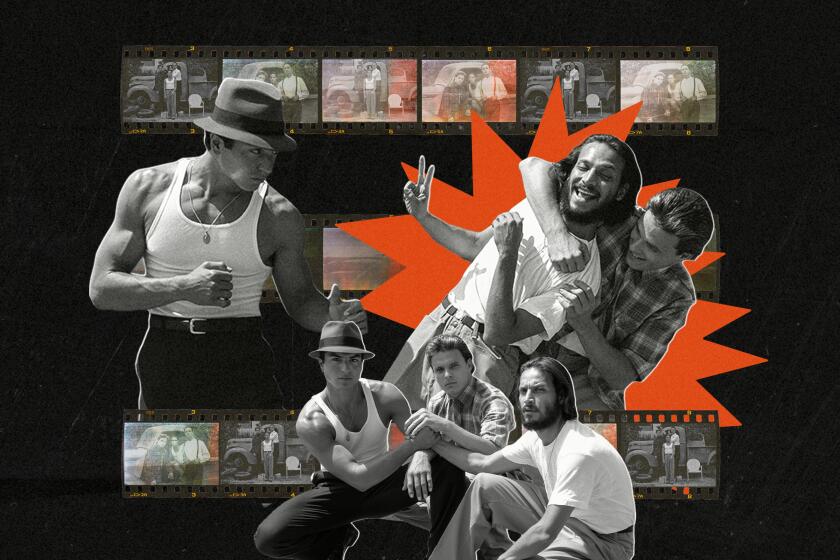This photographer has documented Southern California’s street gang culture for 40 years
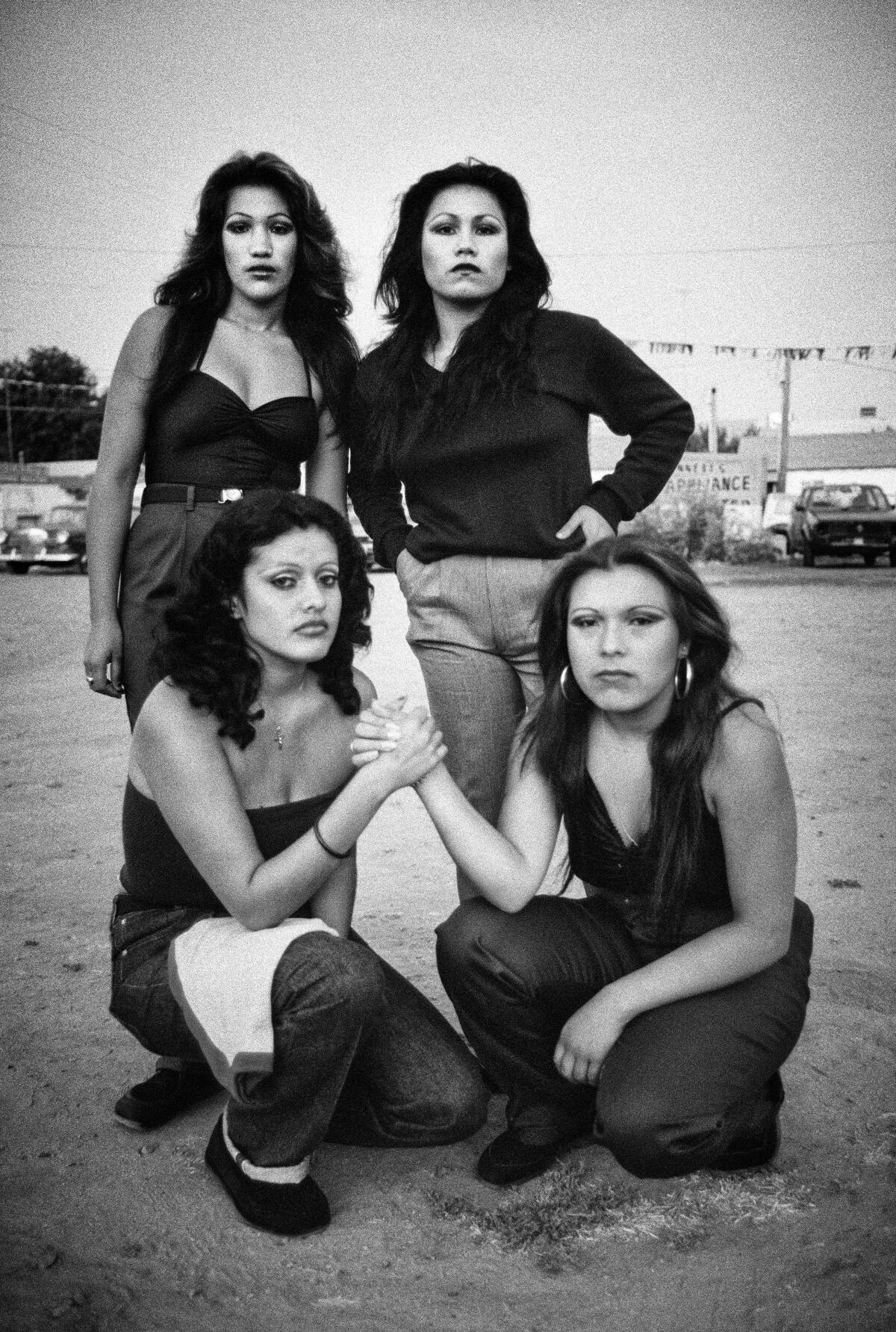
On a rainy March evening, a group of roughly a hundred people huddled inside the Eastern Projects art gallery in Chinatown for the opening of “Un-Rehearsed,” the first solo show for photographer Merrick Morton, on display until May 18.
Adorning the walls of the space are more than 100 images spanning a 40-year trajectory— selections from his travels in Mexico and Cuba, and stills from various films where he worked as on-set photographer. The bulk of the art, however, focuses on a subject Morton has become deeply associated with: Southern California gang life.
Many of these stills also appear on “Clique: West Coast Portraits From the Hood, 1980-1996,” a glossy, 224-page monograph set to be released by independent publisher Hat & Beard Press later this spring.
One photograph features an older couple standing on the porch of their home as the lifeless body of a drive-by shooting victim lies on the sidewalk. Another shows a gang member from Barrio Logan Heights in San Diego awaiting treatment at an area hospital after being stabbed. Other prints showcase cliques of young Latino and Black men hanging out, or homegirls embracing each other.
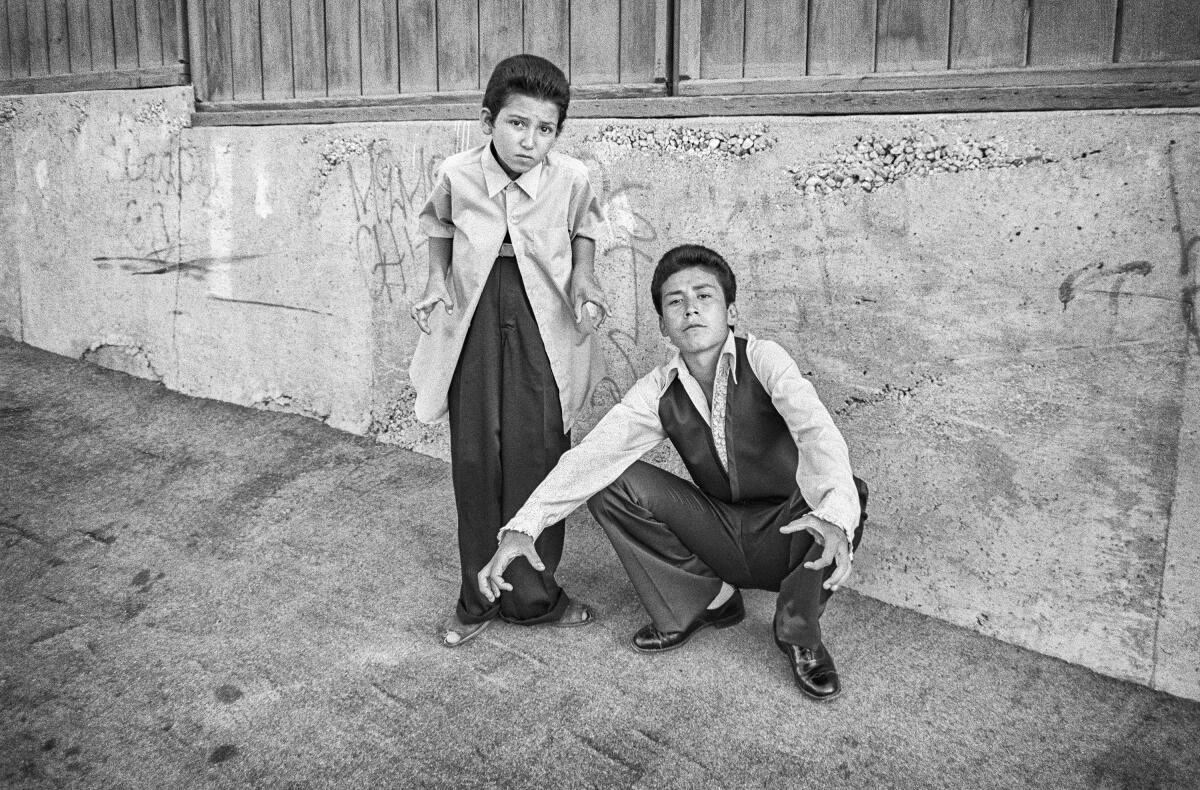
Born in 1955 and raised in the suburbs of the San Fernando Valley, the soft-spoken Morton says his interest in chronicling street life began after a visit with John M. Valadez, the L.A.-based realist muralist and painter who was instrumental in the 1970s Chicanx art movement.
“I’m thinking, ‘I have to photograph [them]’,” he said of the cholos and cholas featured in Valadez’s artwork.
Morton, who is white, did not have a direct connection to these communities. He began calling probation officers after learning from a friend that they could be his way in. “I told them I was working on a documentary photography essay on Los Angeles street gangs,” he recalled. Eventually, he was assigned to Gerald Ivory, who introduced him to his parolees, mainly members of the Maravilla gang in East L.A. In 1981, Morton began photographing them at the Obregon Park recreation center, where he had set up a portable studio.
Morton says he and Ivory would “hit the streets,” recording interviews with various gangs throughout the ‘80s. Their work “was never sanctioned by the L.A. County Probation Department,” he said.
You’re reading Latinx Files
Fidel Martinez delves into the latest stories that capture the multitudes within the American Latinx community.
You may occasionally receive promotional content from the Los Angeles Times.
“My dad said this guy just showed up with a camera, wanting to document neighborhoods in L.A.,” said Breanna Quintero, who attended the show’s opening. Her father grew up in Carson and was photographed by Morton in the early ‘80s at Victoria Park.
“People have to realize that kids from the neighborhood, like my dad, didn’t have cameras because they couldn’t afford them. So, I’m thankful that Merrick got to photograph him; this is a piece of how I grew up,” added Quintero. “These pictures brought his stories to life.”
It didn’t take long for Morton to be known as “the guy” chronicling gang life, thanks in large part to his quiet demeanor and knowing when to not overstep.
“As an observer, I start on the outside and then wait until I’m granted access,” he said. “I’m not going aimlessly into somewhere trying to take over. I think to me, it’s about respect. If you show [it], they’ll respect you.”
In 1984, Morton began freelancing for L.A. Weekly, a gig that would change his life. His work at the alternative weekly caught the eye of Taylor Hackford and Luis Valdez, the producer and director-screenwriter of “La Bamba,” the iconic 1986 Chicanx film about the life and untimely death of musician Ritchie Valens.
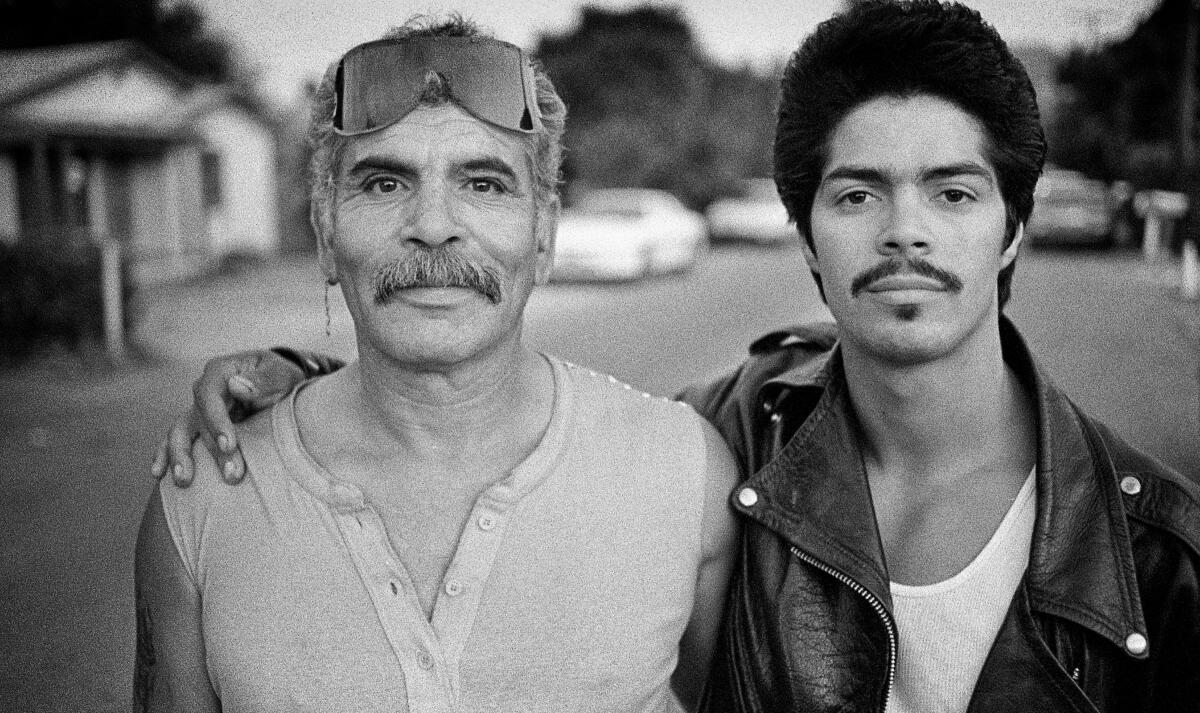
“[Hackford] liked the work that I was shooting in Mexico at the time, outside of the gangs, so I was hired on that,” said Morton. “And for me, at the time, I was working at a camera store and not earning that much there.”
Since then, Morton has worked as on-set still photographer for more than 90 different films and television shows, including “Colors,” “The Big Lebowski,” “Fight Club,” and “Blood In Blood Out” — his work on this latter film is prominently featured in a book (also printed by Hat & Beard Press) that chronicles the making of the East Los Angeles cult classic.
Morton would distance himself from street photography in the late 1990s to work solely in the entertainment industry, only to pick it up again in 2017— he began posting his old work on Instagram, where he’s amassed nearly 70,000 followers. He says using the social media platform has allowed him to reconnect with some of his past subjects—or if they were no longer alive, with their loved ones — who have added context to his images.
One popular social media post shows two photographs of a mother and her child taken 40 years apart.
“I wouldn’t know about many of their stories without Instagram,” he says. “It’s surreal hearing about them.”
Morton intends to continue posting his work in hopes that it reaches people unfamiliar with gang life. “I am trying to provoke some type of dialogue,” he says.
“When I first went into these neighborhoods, I was instilled with this perception of violence,” Morton added. “But I quickly learned that [it’s] such a small part of these neighborhoods. It’s really all about family, culture and heritage. Hopefully, these are the stories that come out of it.”
When asked if anyone had expressed concern that his work exploited or glorified gang violence, Morton says that “it’s a fine line,” explaining that “sometimes the images are an avenue to start talking about how do we stop the killing or why are people killing each other.”
For Marcos Cazarin, who posed for Morton in 1986, the photographer’s work is not exploitative — it’s recordatory.
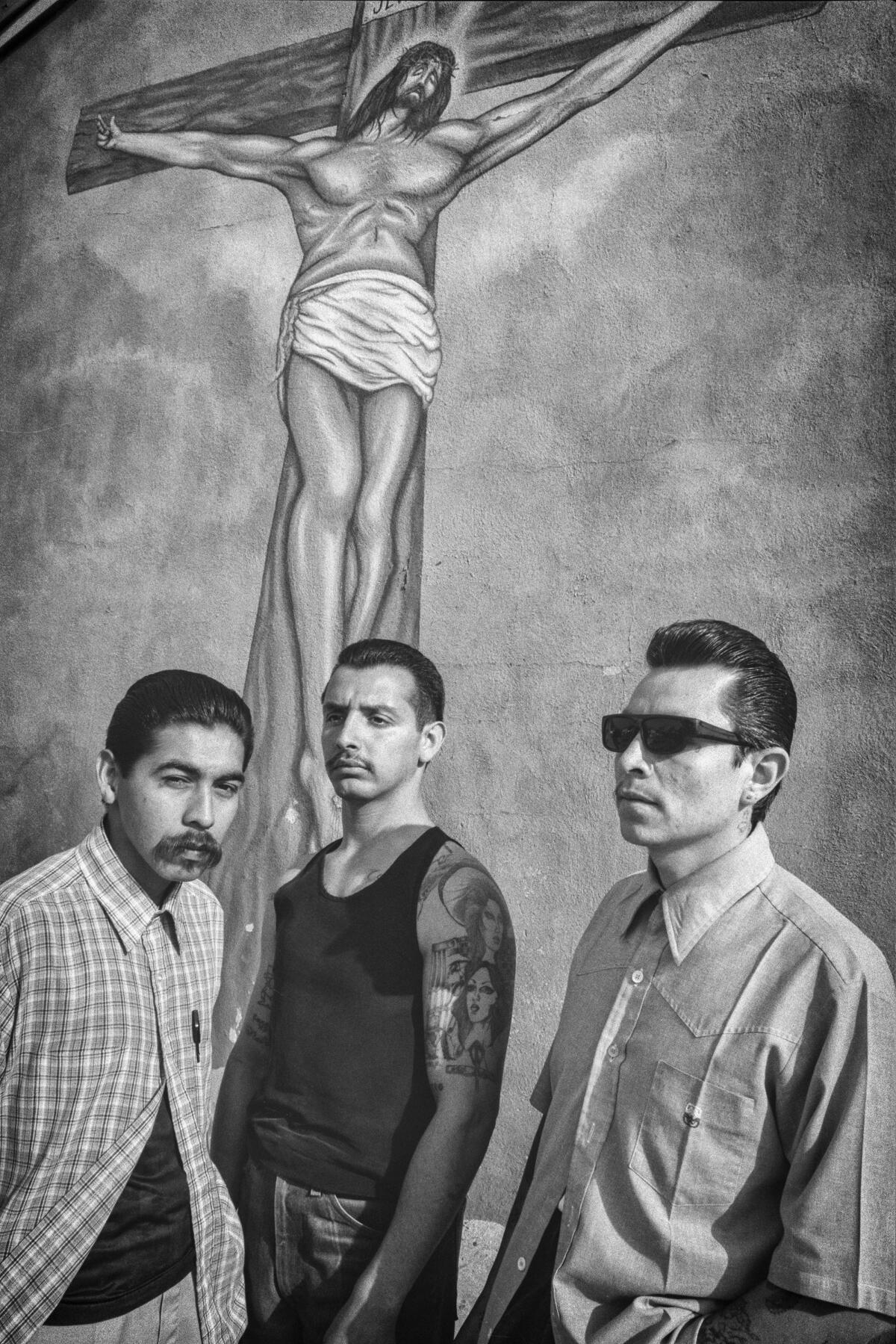
Cazarin, who was at the show opening, says the image of him posing with two friends in front of a mural of the crucifixion of Jesus is a reminder of the life he left behind— he’s in the middle in the image above, wearing the black tank top. The photograph also graces the cover of Morton’s book.
“I am a recovering addict,” he says. “Twenty-one years clean. It was a hard life for anyone growing up in that era. But I learned never to shut the backdoor. I always keep it open to remind myself where I don’t want to be again.”
— Sarah Quiñones Wolfson
Consider subscribing to the Los Angeles Times
Your support helps us deliver the news that matters most. Become a subscriber.
Shape your L.A.
In October 2022, the L.A. Times launched “Shape Your L.A,” an incredibly handy tool that provides tons of useful information to Angelenos. Want to know how to throw a block party or where you can find the closest community garden? We’ve got you covered — all you have to do is go to this link, enter your address and voila!
But wait, there’s more! In February, the team behind “Shape Your L.A.” added several new features, including making the tool available in Spanish for the more than 3 million voting-age Angelenos who speak the language. So, if you have a tío or an abuelita who wants to be civically engaged but doesn’t know where to turn to for information, make sure you share this link with them
— Fidel Martinez

Things we read this week that we think you should read
From the L.A. Times
These Latina queens will be on Season 9 of ‘RuPaul’s Drag Race All Stars’
Drag race fans get excited!The cast of Season 9 of “RuPaul’s Drag Race All Stars’” was announced Tuesday. Three Latina queens are among the eight contestants who will be vying for a chance to win $200,000 for the charity of their choice: Vanessa Vanjie Mateo, Jorgeous and Roxxxy Andrews. De Los reporters put together a quick primer so you could get to know these queens better ahead of the May 17 premiere.
She told TikTok she was lonely in L.A. What happened next changed her life
When reaching adulthood, fostering friendships can get difficult. That’s why Emmely Avila created Los Angeles Friends (LAF), a group that invites Angelenos to branch out and meet new people. Over a year ago, she took her expressed her feelings of loneliness and her wanting to expand her social circle to TikTok. Her video received more than a hundred comments of people feeling the same way. Avila took it upon herself to start hosting community events. Celebrating the community’s friendiversary, reporter Claire O’Callahan shares the full story behind the L.A.-based friend group.
Column: Melissa Barrera is not afraid
Last November, actress Melissa Barrera was fired from a role in the “Scream” franchise because of her social media posts she made in support of the Palestinian people.
“I did have opportunities taken away from me, but I always trusted God, trusted that everything was going to work out for me. I have angels that are looking out for me, and I knew I was going to be OK,” said Barrera, who spoke with De Los contributing columnist JP Brammer to promote her new horror film, “Abigail.”
AI-powered cameras installed on Metro buses to ticket illegally parked cars
By the end of 2024, Los Angeles Metro will implement AI-powered cameras on city buses in hopes of cracking down on cars illegally parked in bus lanes. If all goes well, Metro hopes these cameras will increase ridership and improve bus times.
Xochitl Gomez’s 5 favorite Latino-owned businesses in L.A.
Echo Park is the center of Xochitl Gomez’s Los Angeles. The 17-year-old actor and most recent winner of “Dancing With the Stars” shares her favorite spots in the northwest neighborhood in the latest installment of “Mi Los Angeles.” Whether you’re looking for a new coffee spot, bakery or even vintage furniture store, Gomez offers some guidance.
Meet the homeless L.A. immigrants who built a DIY home in gentrifying Highland Park
Alongside the Arroyo Seco flood channel in Highland Park, there is a small community of unhoused people who have built intricate makeshift homes. In conversation with some residents, Solis reports on the realities of being unhoused in Los Angeles.
Documentary filmmaker and social activist Lourdes Portillo dies at 80
Influential documentarian Lourdes Portillo passed away of cholangiocarcinoma, a kind of bile duct cancer, earlier this week. The Mexico native spent her life making documentaries that shed light on working-class struggles; some of her most notable works being “The Devil Never Sleeps” and “The Mothers of the Plaza de Mayo.” In celebration of her life and accomplishments, there’s no better time than now to watch her documentaries.
Where to eat and drink near Dodger Stadium before or after a game
Dodgers season is in full swing. Whether you’re stopping for a beer before the game or looking for some late-night tacos, assistant Food editor Danielle Dorsey has covered all the bases. Check out one of these spots next time you’re headed to the Elysian Park area.
From elsewhere
How do you get siblings to be nice to each other? Latino families have an answer
In its new series “The Science of Siblings,” NPR examines the relationship between siblings and their influences. In this episode, Michaeleen Doucleff explores research surrounding how parents can raise their children to care for and love their siblings. Looking at various cultures, she chose to closely follow a Latino family in Texas. Through the family’s anecdotes and pieces of advice, she reports on why and how Latino siblings and families are more likely to be amicable and happy.
Biden steps up Latino outreach as warning signs flash
Over the past month, the Biden campaign has put a significant emphasis on reaching Latinx voters. Politico has compiled this list of Biden’s efforts with this sought-after electorate.
— Cerys Davies
The Latinx experience chronicled
Get the Latinx Files newsletter for stories that capture the multitudes within our communities.
You may occasionally receive promotional content from the Los Angeles Times.

